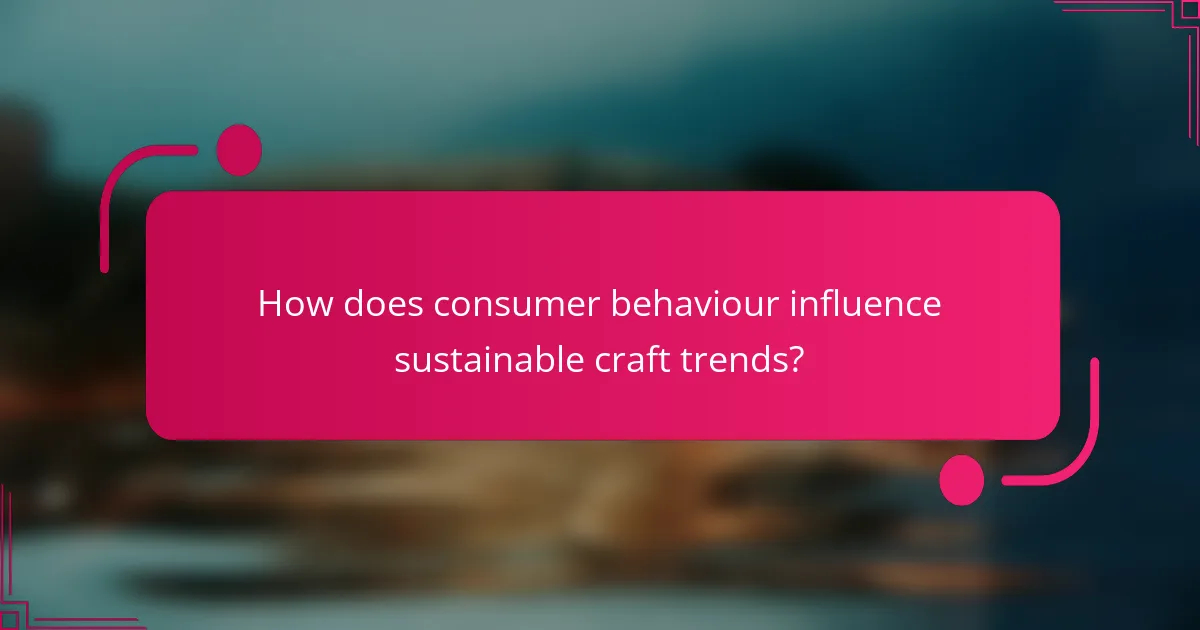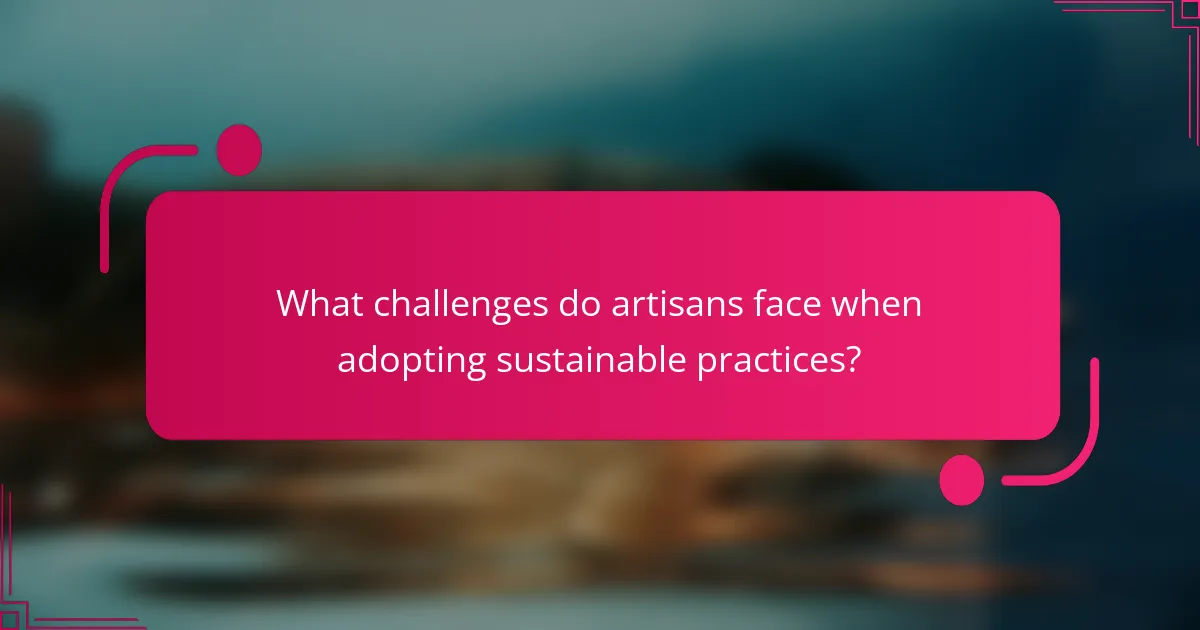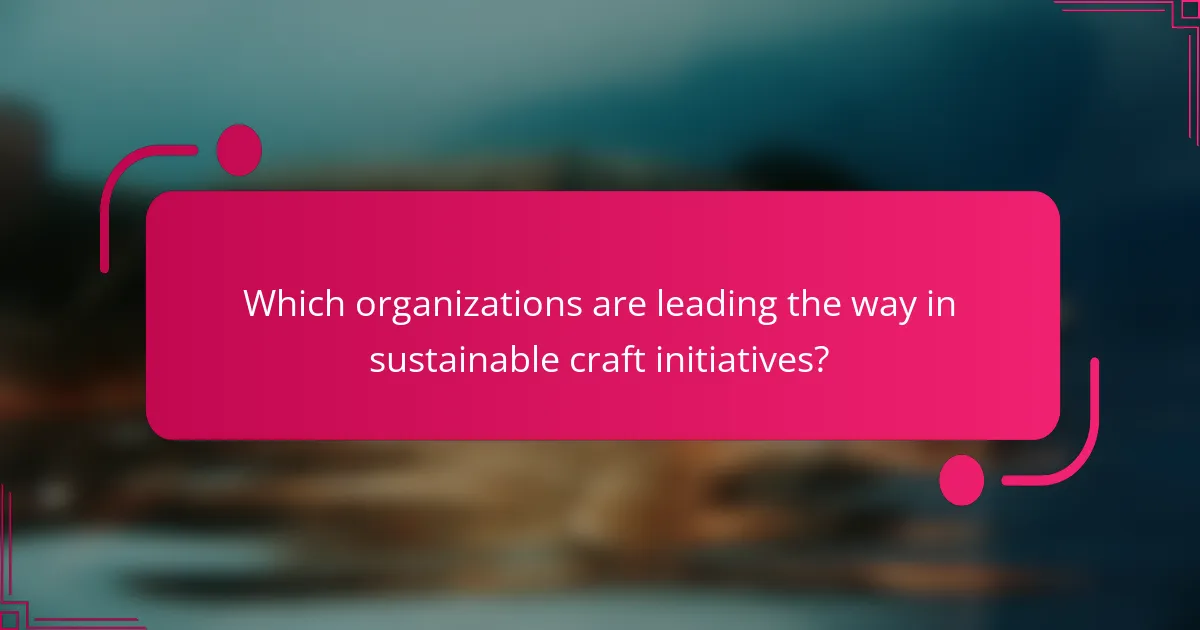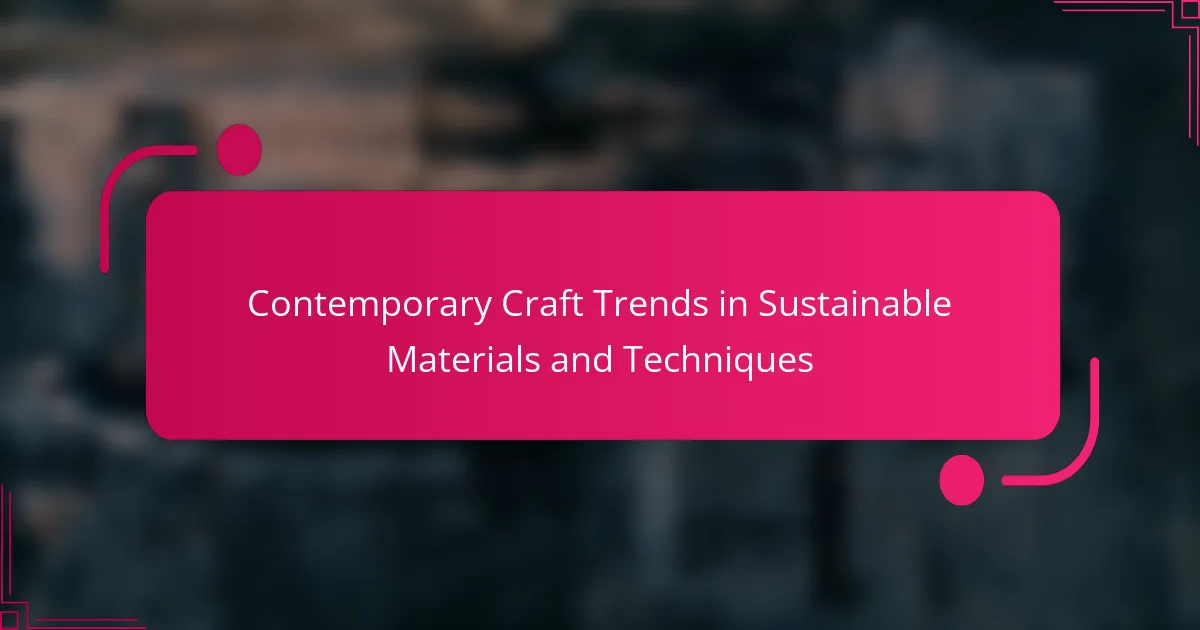Sustainable materials and techniques are reshaping contemporary craft, addressing environmental responsibility and consumer demand. This article explores key principles of sustainability, innovative practices like upcycling and digital fabrication, and the role of community engagement. It also examines the challenges artisans face and highlights leading organizations driving these trends. Finally, future directions in biodegradable and eco-friendly materials will be discussed.

What are the key principles of sustainable materials in contemporary craft?
The key principles of sustainable materials in contemporary craft focus on environmental responsibility, resource efficiency, and social equity. Craft practitioners prioritise using renewable resources, minimising waste, and selecting materials with low environmental impact.
Materials such as reclaimed wood, recycled metals, and organic textiles exemplify sustainable choices. Techniques like upcycling and natural dyeing further enhance sustainability, promoting a circular economy.
Collaboration with local artisans and communities fosters social responsibility and supports traditional craftsmanship. This approach not only preserves cultural heritage but also strengthens community ties, ensuring sustainable practices are rooted in shared values.
In summary, sustainable materials in contemporary craft emphasise ecological integrity, resource conservation, and social inclusivity, creating a holistic framework for responsible making.
How do sustainable materials impact environmental conservation?
Sustainable materials significantly enhance environmental conservation by reducing waste and minimising resource depletion. They often utilise renewable resources and promote recycling, which lowers carbon footprints. For instance, bamboo and recycled plastics serve as eco-friendly alternatives in contemporary crafts. These materials contribute to a circular economy, fostering responsible production and consumption patterns. Additionally, their use in crafting supports local economies and encourages sustainable practices among artisans.
Which sustainable materials are trending in 2025?
Sustainable materials trending in 2025 include mycelium, recycled ocean plastics, bamboo, hemp, and bio-based composites. These materials are gaining popularity due to their eco-friendly properties and innovative applications in contemporary craft. Mycelium, derived from fungi, offers a unique, biodegradable alternative for packaging and textiles. Recycled ocean plastics are being repurposed into durable products, reducing marine pollution. Bamboo and hemp are celebrated for their rapid growth and renewability, making them ideal for sustainable construction and textiles. Bio-based composites combine natural fibres with resins, creating versatile materials for various industries.
What are the benefits of using recycled materials in crafts?
Using recycled materials in crafts offers environmental, economic, and creative benefits. It reduces waste, conserves resources, and encourages innovative design.
Recycling materials lowers the demand for new resources, which helps decrease pollution and energy consumption. This practice supports local economies by providing affordable materials for crafters.
Additionally, using recycled materials fosters creativity. Crafters can experiment with unique textures and forms, resulting in one-of-a-kind pieces. This approach promotes sustainability in the craft community, aligning with contemporary trends.
As a result, the use of recycled materials not only contributes to environmental preservation but also enhances the crafting experience through creativity and resourcefulness.
How do local sourcing practices enhance sustainability?
Local sourcing practices enhance sustainability by reducing transportation emissions, supporting local economies, and promoting the use of regional materials. This approach minimises the carbon footprint associated with long-distance shipping. Additionally, it fosters community resilience by keeping resources within local networks. Sustainable materials sourced locally often exhibit unique attributes, such as lower environmental impact and cultural relevance. As a result, contemporary craft trends increasingly favour these practices to align with eco-conscious consumer preferences.

What innovative techniques are shaping contemporary craft practices?
Innovative techniques shaping contemporary craft practices include the use of sustainable materials, digital fabrication, and community-driven approaches. These methods emphasise environmental responsibility and collaboration. For example, artisans are increasingly utilising recycled materials, which reduces waste and promotes sustainability. Digital tools, such as 3D printing, enable precise designs and customisation, enhancing creativity. Additionally, community engagement fosters shared knowledge and skills, leading to unique local crafts. These trends reflect a shift towards more conscious and innovative craft practices in today’s society.
How is technology influencing sustainable crafting methods?
Technology is enhancing sustainable crafting methods by introducing innovative tools and materials. Digital fabrication techniques, such as 3D printing, allow artisans to create intricate designs using eco-friendly materials. Advanced software enables precise planning, reducing waste during production. Additionally, online platforms facilitate the sharing of knowledge and resources, fostering a community focused on sustainable practices. As a result, crafters can adopt more efficient methods while preserving traditional techniques.
What role do traditional techniques play in modern sustainability?
Traditional techniques significantly enhance modern sustainability by integrating time-tested practices with contemporary materials. These methods often prioritise local resources, reduce waste, and promote craftsmanship, which aligns with sustainable principles. For example, techniques like natural dyeing and hand weaving minimise environmental impact while preserving cultural heritage.
The unique attribute of traditional methods is their ability to foster community engagement, as they often involve local artisans and knowledge transfer. This not only supports local economies but also strengthens social bonds. As a result, the fusion of traditional techniques with modern sustainability creates a holistic approach that values both ecological integrity and cultural significance.
Which techniques are unique to specific craft communities?
Certain craft communities utilise unique techniques that emphasise sustainability. For example, the Japanese Kintsugi technique repairs pottery with lacquer mixed with gold, highlighting imperfections. In weaving, the Navajo community employs a unique method called “rug weaving,” which incorporates natural dyes and traditional patterns. The Scandinavian community often uses “green woodworking,” emphasising hand tools and locally sourced timber. Additionally, the African community showcases “basket weaving,” using native grasses and fibres to create functional art. Each technique reflects cultural heritage and promotes sustainability through local materials and methods.

How does consumer behaviour influence sustainable craft trends?
Consumer behaviour significantly shapes sustainable craft trends by prioritising eco-friendly materials and ethical practices. As consumers become more environmentally conscious, they seek products that reflect their values. This shift drives artisans to adopt sustainable techniques, such as upcycling and using organic materials. Market research indicates that 70% of consumers prefer brands with sustainable practices, showcasing the demand for responsible craftsmanship. Additionally, social media influences consumer choices, amplifying trends and encouraging artisans to innovate sustainably. Ultimately, consumer preferences directly impact the evolution of craft trends in sustainability.
What are the motivations behind consumers choosing sustainable crafts?
Consumers choose sustainable crafts due to environmental concerns, ethical sourcing, and unique aesthetics. They seek to reduce waste and support local artisans. Sustainable materials often provide higher quality and durability, appealing to conscious shoppers. Additionally, the desire for authenticity drives interest in handmade items that reflect individual values.
How do cultural differences affect perceptions of sustainable crafting?
Cultural differences significantly shape perceptions of sustainable crafting. Various cultures prioritise different aspects of sustainability, influencing crafting methods and material choices.
For instance, in some cultures, traditional crafting techniques emphasise community involvement and resource conservation. This contrasts with cultures that focus on innovation and individual expression in sustainable crafting.
Additionally, the value placed on natural versus synthetic materials varies across cultures, affecting how sustainability is perceived. In regions where natural resources are abundant, there may be a stronger inclination towards eco-friendly practices.
Overall, understanding these cultural nuances can enhance the appreciation and effectiveness of sustainable crafting initiatives globally.
Which demographic trends are driving the demand for sustainable crafts?
Growing environmental awareness and a desire for ethical consumption are driving demand for sustainable crafts. Consumers increasingly prioritise eco-friendly materials and artisanal techniques in their purchasing decisions. Younger demographics, particularly millennials and Gen Z, are leading this trend, valuing sustainability as a core principle. As a result, brands that focus on sustainable practices can attract a loyal customer base. Additionally, the rise of social media has amplified the visibility of sustainable crafts, further influencing consumer preferences.

What challenges do artisans face when adopting sustainable practices?
Artisans face several challenges when adopting sustainable practices, including cost, access to materials, and consumer demand. The initial investment in sustainable materials can be high, limiting financial feasibility. Sourcing eco-friendly materials is often difficult due to availability and logistics. Additionally, consumer awareness and demand for sustainable products may not be strong enough to justify the transition. These factors create barriers that artisans must navigate to implement sustainable practices effectively.
How does cost impact the choice of sustainable materials?
Cost significantly influences the selection of sustainable materials. Higher costs often deter artisans from using eco-friendly options, despite their environmental benefits. Budget constraints can limit access to innovative materials, impacting design and craftsmanship. However, as consumer demand for sustainability grows, prices may decrease, making these materials more accessible. Additionally, investing in sustainable materials can enhance brand reputation, potentially leading to higher sales in the long term.
What are common misconceptions about sustainable crafting?
Many believe sustainable crafting is expensive, limited in creativity, and only for eco-enthusiasts. In reality, sustainable materials can be affordable and versatile, allowing for innovative designs. Additionally, sustainable crafting is accessible to anyone interested, not just a niche group. It promotes environmental awareness while fostering community engagement and creativity.
How can artisans overcome barriers to sustainability?
Artisans can overcome barriers to sustainability by adopting innovative practices and collaborating with local communities. Utilizing eco-friendly materials and techniques enhances their craft while minimising environmental impact.
Artisans should focus on education and awareness to understand sustainable practices better. Engaging in workshops and training can provide valuable insights into sustainable methods.
Collaboration with local suppliers can reduce transportation emissions and promote regional economies. This approach fosters a sense of community and shared responsibility towards sustainability.
Moreover, utilising digital platforms for marketing can reach broader audiences, allowing artisans to share their sustainable practices effectively. Emphasising storytelling in their branding can resonate with consumers who value sustainability.

Which organizations are leading the way in sustainable craft initiatives?
Leading organizations in sustainable craft initiatives include the Crafts Council, the American Craft Council, and the Center for Craft. These entities promote eco-friendly materials and techniques, fostering innovation in the craft community. The Crafts Council focuses on sustainability education, while the American Craft Council supports artists through grants and resources. The Center for Craft emphasizes research and collaboration, enhancing sustainable practices across various craft sectors. Together, they significantly influence contemporary craft trends, driving the adoption of sustainable methodologies.
How do community workshops promote sustainable crafting?
Community workshops promote sustainable crafting by fostering collaboration, sharing knowledge, and encouraging eco-friendly practices. Participants learn to utilise sustainable materials and techniques, enhancing their skills while reducing environmental impact. These workshops often emphasise local resources, creating a sense of community and supporting local economies. As a result, they cultivate a culture of sustainability that extends beyond the workshop, inspiring participants to adopt sustainable crafting practices in their daily lives.
What partnerships are emerging to support sustainable artisans?
Emerging partnerships supporting sustainable artisans focus on collaboration between brands, non-profits, and local communities. These alliances enhance resource sharing, promote ethical practices, and elevate artisan visibility. For example, brands are increasingly partnering with non-profit organizations to provide training and access to markets. This synergy boosts artisans’ skills while ensuring sustainable material use. Additionally, collaborations with eco-conscious brands foster innovation in sustainable techniques, creating a vibrant ecosystem for artisans. These partnerships not only empower artisans economically but also contribute to preserving cultural heritage and promoting environmental sustainability.
Which events showcase sustainable craft innovations?
Events showcasing sustainable craft innovations include design fairs, art exhibitions, and workshops focused on eco-friendly materials and techniques. Notable examples are the London Design Festival, Milan Design Week, and the Craft and Design Month. These events highlight the integration of sustainability in contemporary craft, emphasising innovative practices that reduce environmental impact. They feature artisans and designers who prioritise renewable resources and ethical production methods, fostering a community dedicated to sustainable craftsmanship.

What future trends are anticipated in sustainable materials and techniques?
Future trends in sustainable materials and techniques include increased use of biodegradable composites, innovative recycling methods, and bio-based materials. These developments aim to reduce environmental impact and enhance resource efficiency. For example, mycelium-based products are gaining popularity for their low carbon footprint. As a result, industries are shifting towards circular economy practices and sustainable sourcing, driving demand for eco-friendly solutions.
How will emerging technologies reshape sustainable crafting?
Emerging technologies will significantly enhance sustainable crafting by optimising resource use and reducing waste. Innovations like 3D printing enable precise material application, minimising excess. Digital design tools facilitate eco-friendly practices, allowing artisans to experiment with sustainable materials more efficiently. Smart materials, incorporating sensors, can adapt to environmental conditions, improving functionality and longevity. These advancements foster a culture of sustainability while expanding creative possibilities for contemporary artisans.
What role will education play in promoting sustainable practices?
Education plays a crucial role in promoting sustainable practices by equipping individuals with knowledge and skills. It fosters awareness of environmental issues and encourages responsible decision-making. Programs focused on sustainable materials and techniques inspire innovation in contemporary crafts. For example, courses on eco-friendly design practices enable artisans to reduce waste and utilise renewable resources. Research indicates that educational initiatives can significantly enhance community engagement in sustainability efforts.
How can artisans prepare for the evolving landscape of sustainable crafts?
Artisans can thrive in the evolving landscape of sustainable crafts by embracing innovative materials and techniques. They should focus on sourcing eco-friendly materials, such as organic fibres or recycled components, which reduce environmental impact. Collaboration with local suppliers enhances community ties and supports sustainable economies.
Continuous education on sustainable practices is crucial. Workshops and online courses can provide artisans with the latest trends and techniques in sustainable crafting. For example, learning about natural dyeing methods or zero-waste design can set artisans apart in a competitive market.
Networking within the sustainable craft community offers valuable insights and opportunities. Joining organizations or attending fairs dedicated to sustainable crafts can help artisans share knowledge and resources, fostering a supportive environment.
Lastly, promoting their work through social media and online platforms can reach a wider audience. Artisans should highlight their commitment to sustainability in their branding, attracting eco-conscious consumers who value ethical craftsmanship.
What best practices should artisans follow for sustainable crafting success?
Artisans should prioritise eco-friendly materials, efficient production methods, and community engagement for sustainable crafting success. These practices enhance environmental responsibility while fostering creativity and innovation.
1. Use renewable resources like bamboo and organic cotton.
2. Implement waste-reduction techniques such as upcycling.
3. Adopt energy-efficient processes to minimise carbon footprint.
4. Engage with local communities to source materials responsibly.
5. Educate consumers on the benefits of sustainable products.
6. Continuously innovate to stay aligned with evolving sustainability trends.
